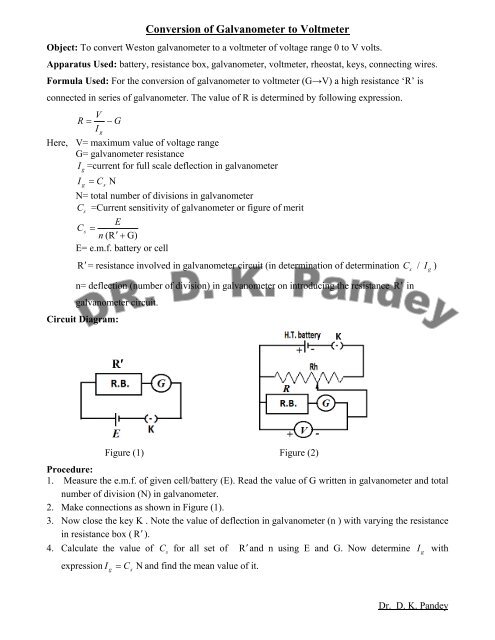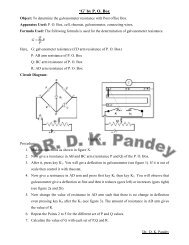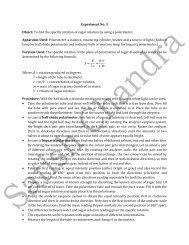Conversion of Galvanometer to Voltmeter
Conversion of Galvanometer to Voltmeter
Conversion of Galvanometer to Voltmeter
- No tags were found...
You also want an ePaper? Increase the reach of your titles
YUMPU automatically turns print PDFs into web optimized ePapers that Google loves.
<strong>Conversion</strong> <strong>of</strong> <strong>Galvanometer</strong> <strong>to</strong> <strong>Voltmeter</strong>Object: To convert Wes<strong>to</strong>n galvanometer <strong>to</strong> a voltmeter <strong>of</strong> voltage range 0 <strong>to</strong> V volts.Apparatus Used: battery, resistance box, galvanometer, voltmeter, rheostat, keys, connecting wires.Formula Used: For the conversion <strong>of</strong> galvanometer <strong>to</strong> voltmeter (G→V) a high resistance ‘R’ isconnected in series <strong>of</strong> galvanometer. The value <strong>of</strong> R is determined by following expression.R =VIg− GHere, V= maximum value <strong>of</strong> voltage rangeG= galvanometer resistanceIg=current for full scale deflection in galvanometerIg= C sNN= <strong>to</strong>tal number <strong>of</strong> divisions in galvanometerCs=Current sensitivity <strong>of</strong> galvanometer or figure <strong>of</strong> meritEC s= n ( R′+ G)E= e.m.f. battery or cellR′= resistance involved in galvanometer circuit (in determination <strong>of</strong> determinationn= deflection (number <strong>of</strong> division) in galvanometer on introducing the resistance R′ ingalvanometer circuit.Circuit Diagram:Cs/ Ig)Figure (1) Figure (2)Procedure:1. Measure the e.m.f. <strong>of</strong> given cell/battery (E). Read the value <strong>of</strong> G written in galvanometer and <strong>to</strong>talnumber <strong>of</strong> division (N) in galvanometer.2. Make connections as shown in Figure (1).3. Now close the key K . Note the value <strong>of</strong> deflection in galvanometer (n ) with varying the resistancein resistance box ( R′).4. Calculate the value <strong>of</strong> C sexpression Nfor all set <strong>of</strong> R′and n using E and G. Now determine I gwithI = and find the mean value <strong>of</strong> it.gC sDr. D. K. Pandey
5. See in galvanometer, a value <strong>of</strong> current is written in it, this is I g. If your calculated I gisapproximately same with this value then observation up <strong>to</strong> this point is correct. If it is not true thenrepeat/check the process 3→4.V6. After it, calculate the value <strong>of</strong> R with the formula R = − G . Now make the circuit shown inIgFigure 2 and introduce the calculated resistance R in resistance box.7. Now vary the deflection in galvanometer from 2→30 divisions in interval <strong>of</strong> 2 with help <strong>of</strong> rheostatand note the corresponding voltmeter readings (V).8. If V is maximum voltage <strong>of</strong> given voltage range then voltage equal <strong>to</strong> one division ongalvanometer is V/N. Using it convert galvanometer deflections in volt ( V′).9. Now calculate the difference <strong>of</strong> V and V′. If value <strong>of</strong> V and V′are approximately same or theirdifference is <strong>to</strong>o much small then the conversion <strong>of</strong> G→V is correct.Observation:1. E= ……..volt2. G= ……..Ω3. N= ……..4. Table for IgSr.No. R′(Ω) n CsIg(A)1. 50002. 60003. 70004. 80005. 90006. 100005. Calibration <strong>of</strong> shunted galvanometerSr.No. <strong>Galvanometer</strong> reading <strong>Voltmeter</strong> readingIn division In volt ( V′) V ( in volt)mean I g(in A or µA)Error V′-V(in volts)Calculation: Show all calculations <strong>of</strong>Cs, Igand R.Result: The resistance required <strong>to</strong> convert the given galvanometer in <strong>to</strong> voltmeter <strong>of</strong> range <strong>of</strong> ….. voltsis ……(Ω).Precaution:Precautions:1. Resistance in determination <strong>of</strong> figure <strong>of</strong> merit should be <strong>of</strong> high value.2. Exact high resistance should be connected in series <strong>to</strong> galvanometer for conversion <strong>to</strong> voltmeter.3. <strong>Voltmeter</strong> should be connected using sign convention.4. <strong>Voltmeter</strong> used in calibration <strong>of</strong> shunted galvanometer should be <strong>of</strong> nearly same range.5. In calibration process the readings should be noted from zero.Dr. D. K. Pandey



![Ã
tkZ % laHkkouk;sa] mi;ksx vkSj laj{k.kA Energy : Explore, Harness ...](https://img.yumpu.com/49782265/1/190x245/atkz-lahkkouksa-miksx-vksj-lajkka-energy-explore-harness-.jpg?quality=85)


